From where could the polycyclic aromatic hydrocarbons (PAHs) in the Illinois River sediments have come? Researchers from the University of Illinois at Chicago with a grant from the Hazardous Waste Research Fund investigated possible sources. The details of their research is in the newly published technical report Tr-058, titled “Source Apportionment of Polycyclic Aromatic
Hydrocarbons in Illinois River Sediment.”
ABSTRACT
The accumulation of over six million metric tons of sediment annually in the Illinois River Valley degrades its recreational, commercial, and ecological value. This necessitates dredging a large volume of sediment to restore water depth and makes beneficial reuse of the sediment a priority. Unfortunately, many reuse applications are limited by contamination from polycyclic aromatic hydrocarbons (PAHs), particularly benzo(a)pyrene in the sediments. Existing contaminant standards do not consider whether the sources of PAHs are from current petroleum combustionbased inputs or whether they represent “legacy pollution” such as coal dust released from barges, trucks, and storage. The latter is typically found in black carbon form that might be less bioavailable, and thus may not represent as high a risk for beneficial reuse. A source apportionment (SA) analysis was undertaken to identify the sources of PAHs to the Illinois River and to determine if they come from these potentially low bioavailable forms.
Priority PAHs were analyzed in 80 sediment cores sampled from Illinois River pools and backwater lakes between Hennepin, Illinois and the Peoria Lock and Dam. PAH diagnostic ratio analysis and a Positive Matrix Factorization (PMF) multivariate receptor model were used to characterize the PAH dataset, identify specific sources of pollutants, and quantify source contributions to the river sediment. Predicted sources from the SA analysis were identified using a database of compiled reference PAH profiles for coal dust, coal tar sealcoat, motor oils, biosolids, as well as fossil fuel combustion residues from gasoline and diesel engines, power plants, and coke production.
Three sources (S1, S2, and S3) were required to reconstruct most of the variation in the Illinois River contaminant dataset by PMF source apportionment. PMF results suggested that a mixed upland source and coal-derived sources including coal tar sealcoat (S1 and S2, 75%) were major contributors to sediment PAHs in the Illinois River, as well as a diffuse traffic-based source (S3, 25%). Liquid petroleum was not identified as a signficant source of PAHs to Illinois River sediment. Coal dust was not uniquely resolved from the coal-derived sources and thus could not be assessed for reduced PAH bioavailability. Finally, comparison of PMF results with those from the widely-used PAH diagnostic ratio method indicated that the latter does a relatively poor job of uniquely resolving PAH sources in the sediments.




